
by Deep Green Resistance News Service | Feb 18, 2016 | Biodiversity & Habitat Destruction
By Deep Green Resistance
Wild Bison are an icon of what has been destroyed by civilization, and this species is now on the brink in the wild. Almost all bison left today are cross-breeds held in confinement. There are only a few wild, free ranging bison herds left on the planet, and their numbers are small. Every year, the Park Service — at the behest of ranchers — round up, quarantine, harass, and kill many of the wild bison who live in and around Yellowstone National Park. We stand with grassroots land defenders such as the Buffalo Field Campaign in calling for an immediate end to this atrocious treatment of wild bison. Instead of quarantine, these creatures need room to roam. Instead of harassment, they need our assistance in growing once again to their historical numbers.

From Buffalo Field Campaign:
Yellowstone National Park has released an Environmental Assessment (EA) for a fifty-year quarantine program which seriously threatens America’s last wild, migratory bison population. Unfortunately there is very little in this EA for bison advocates to support, as even the “no action” alternative maintains the Park’s ongoing capture-for-slaughter program. Comments are due by midnight MDT February 29, 2016. (This is a new, extended deadline.)
Quarantine domesticates wild bison, subjects them to artificial selection and commercial management practices and treats them like livestock. Quarantine is an insult to First Nations buffalo cultures with strong cultural, spiritual, and traditional ties to wild, migratory buffalo in and around Yellowstone. Quarantining wild, migratory bison and dooming them to a life behind fences ignores the critical keystone relationship between wild bison and their natural prairie and grassland communities. Migration is one of the buffalo’s strongest, most significant gifts to a healthy landscape. Quarantine reduces buffalo to a domesticated state, and is not appropriate for wildlife. Quarantine, which imposes a state of control and surveillance over wild bison, is the direct result of the livestock industry’s intolerance. Quarantine is a toxic mimic of natural restoration, a program in which humans manipulate the wild and free to suit their own selfish agendas. Quarantine does not end slaughter, it begins with it, ripping buffalo families apart and orphaning calves who spend the rest of their lives behind fences.
Yellowstone’s ongoing capture-for-slaughter and fifty-year quarantine plan will result in extremely adverse cumulative impacts, and we need to force the agency to seriously and honestly review the best available scientific information in a comprehensive Environmental Impact Statement (EIS).
Recent history has already shown that quarantine does not work for wild bison. The Quarantine Feasibility Study that began in 2005 resulted in wild Yellowstone buffalo being commercially owned for profit, while some of the buffalo who went to Ft. Peck died in a horrible fire because they could not escape their enclosure, and half of the herd that was transferred to Ft. Belknap died because they could not escape their enclosure to find fresh water. Wild bison do not belong behind fences, they are a nation unto themselves who evolved to migrate, wild and free!
TAKE ACTION! Please use the sample letter below only as an example, and in your own words, address the adverse impacts of quarantining wild bison and the Park’s ongoing capture for slaughter mismanagement scheme. Don’t allow Yellowstone National Park to domesticate wild, migratory bison!
HOW TO SEND YOUR COMMENTS: Respondents are encouraged to submit their comments online through the Planning, Environment and Public Comment (PEPC) website at www.parkplanning.nps.gov/BisonQuarantine. Comments may also be hand-delivered to the park administration building, or mailed to: Superintendent, Yellowstone National Park, Wyoming, 82190. Comments will NOT be accepted by fax, e-mail, or in any manner other than those specified above.
SAMPLE LETTER – Please edit with your own remarks! See above for instructions on how to submit your comments. Due by February 29, 2016.
Superintendent Dan Wenk
Yellowstone National Park
Attn: Bison Quarantine EA
P.O. Box 168
Yellowstone National Park, Wyoming 82190
RE: Comments on Yellowstone Bison Quarantine Program EA
Dear Superintendent Wenk,
Thank you for the opportunity to comment on Yellowstone’s quarantine environmental assessment (EA). I am strongly opposed to Yellowstone’s proposed fifty-year quarantine plan as well as the Park’s ongoing capture-for slaughter operations. As an advocate for wild, migratory bison, I find it impossible to support quarantine in Yellowstone or elsewhere, or your no-action alternative to continue capturing wild buffalo for slaughter.
Yellowstone’s proposed fifty-year quarantine plan, as well as the Park’s ongoing capture-for-slaughter operations have significant cumulative negative impacts, which requires your agency to seriously and thoroughly review the best available information in a comprehensive Environmental Impact Statement.
The U.S. Congress never intended for wild buffalo in Yellowstone to be declared “surplus” and did not authorize the Secretary of the Interior to remove wild buffalo as “surplus” for quarantine. By regulation, Yellowstone National Park is prohibited from removing “surplus” wild buffalo from the population in Yellowstone “when the animals are to be slaughtered, or are to be released without adequate protection from premature hunting.” 36 C.F.R. § 10.3(d) (2015).
Yellowstone’s fifty-year quarantine program is in direct violation of the Organic Act and National Park Service policies, as it includes capturing wild bison for quarantine with potential recipients including agricultural or commercial producers, reducing ecologically extinct wild bison to livestock.
Wild bison are further adversely impacted by Yellowstone’s proposed quarantine plan and ongoing capture-for-slaughter operations, which aim to reduce America’s last continuously wild herds to a mere 3,000 animals, and maintain this low population, making wild bison extremely vulnerable by threatening their natural immunity to introduced diseases from cattle and elsewhere, including brucellosis. Such poor management practices increase the risk of wild bison becoming more vulnerable to various diseases as strains become more virulent and persistent. Further, the population target of 3,000 is based on livestock industry politics and lacks scientific or ecological basis.
In recent history, Yellowstone’s participation in the state-federal Quarantine Feasibility Study resulted in the commercialization and privatization of wild bison, making a commodity of our nation’s valued wildlife. It resulted in the domestication of wild bison originating from Yellowstone. All of the wild bison who survived the quarantine feasibility study have been reduced to private livestock or meat behind fences, many of which died throughout the process, through transport to other quarantine facilities, or who suffered horrible deaths by fire and dehydration as a result of their confinement.
The recent quarantine program has been a failure. There is no indication that quarantine with the costly, restrictive, and burdensome requirements of the U.S. Department of Agriculture will in any way lead to the recovery of ecologically extinct wild bison as a wildlife species anywhere in the country. Quarantine domesticates. It harms and degrades the wild integrity of America’s last wild bison population and subjects wild bison to commercial management practices and artificial selection.
Indigenous people of North America have held strong cultural and spiritual ties to wild, migratory buffalo for tens of millennia. Some of these relationships are so deep that the people consider the buffalo to be actual relatives. “Offering” indigenous buffalo cultures the return of their relatives through quarantine and capture-for-slaughter can be viewed as a continuation of the U.S. government’s assimilation program, which aims to make cattle out of wild, migratory bison, and livestock producers out of traditionally nomadic indigenous buffalo cultures.
Ongoing capture-for-slaughter operations and the proposed quarantine program are a violation of the treaty rights held by more than twenty-five sovereign, indigenous nations. The harmful programs of hazing, quarantine, and slaughter prevent wild, migratory bison from restoring themselves on their native landscape, including open and unclaimed public lands. These nation-to-nation treaties, which the federal government has a legal obligation to honor, hold that these indigenous cultures have a sovereign right to hunt, gather, and hold ceremony on open and unclaimed lands. Sadly, wild, migratory bison are absent and unavailable on many of these lands due to these bison management practices.
Yellowstone’s fifty-year quarantine plan further harms wild, migratory bison because quarantine has adverse impacts on herd dynamics, social structure, and collective wisdom handed down through generations. Quarantine negatively modifies wild bison behavior in ways that are unnatural and harmful, including continuing pressures of domestication, conditioning to human manipulation, and artificial selection — all tools for managing livestock, not wildlife. Wild, migratory bison are able to take care of themselves, with no cost or need of interference from humans. Wild bison are able to create and manage their own habitat, while bison behind fences invoke restrictive, costly, and burdensome requirements by the U.S. Department of Agriculture.
Yellowstone National Park’s voluntary agreement to adhere to the highly controversial Interagency Bison Management Plan contradicts the mission of the National Park Service. The Park Service and other IBMP member agencies fail to operate using the best available science and information, falling back instead on expired information and misguided assumptions, in direct violation of the Park Service’s mandate.
Nearly 6,000 ecologically extinct, wild, migratory bison have been killed or eliminated from America’s last continuously wild population with direct and indirect participation from Yellowstone National Park, through capture-for-slaughter, quarantine, hazing fatalities, and the surrender of wild bison for scientific experiment. An independent population viability analysis must be conducted (and funded) by Yellowstone National Park to determine how management actions and consequent cumulative impacts threaten the long-term viability, diversity, integrity, and evolutionary potential of wild, migratory bison. It is also required that an impairment review be undertaken to determine the long-term and cumulative impacts of capture-for-slaughter operations and the proposed fifty-year quarantine program.
There is a win-win situation for wild, migratory bison and indigenous buffalo cultures that does not include the mass killing or domestication of wild bison: natural restoration through the simple and ancient natural phenomenon of migration. Migration corridors must be protected and made available to wild bison by federal, state, and public trust land management agencies, working with private landowners and tribal governments. The migration corridors in and around Yellowstone are a first priority, along with the protection of the bison themselves — both of which are denied under current management. When wild bison are protected and allowed to restore themselves throughout their native range, they will naturally return to the lands that are their birthright, lands they have been forcibly and lethally removed from, where indigenous buffalo cultures are ready to welcome them home.
Sincerely,
[Your name]
Read more at Buffalo Field Campaign. Help support BFC here.
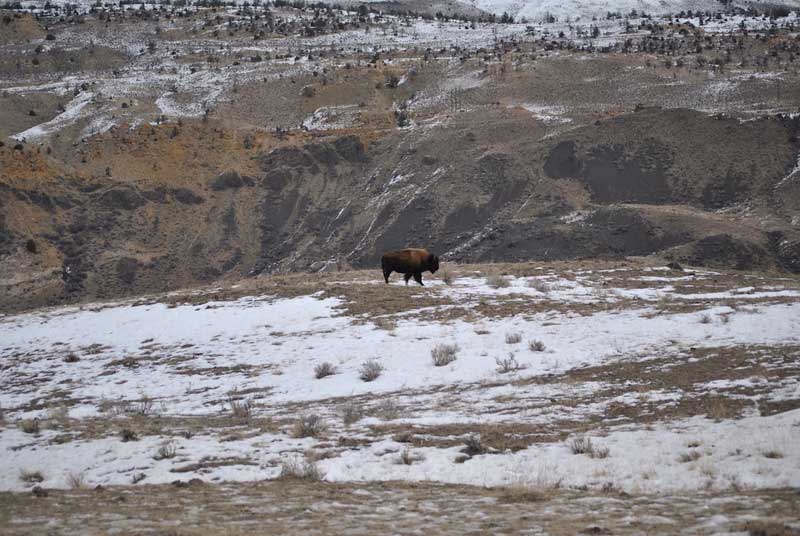
by Deep Green Resistance News Service | Jan 22, 2016 | Biodiversity & Habitat Destruction
By Stephany Seay / Buffalo Field Campaign
Featured image: A young bull buffalo walks the hills in the Gardiner Basin. Photo by Stephany Seay
Based on what we witness in the field everyday, the killing taking place near Gardiner could more accurately be described as a slaughter than a hunt. The tribal game wardens we have spoken with agree, and they recognize that Montana’s livestock interests have organized the circumstances to shift blame away from themselves to the tribes. There is obviously something terribly wrong when every last buffalo to migrate through Beattie Gulch ends up dead, or when hunters feel so desperate to kill every buffalo they see. Whether or not tribal hunters view their hunts as supporting the larger management scheme, the Interagency Bison Management Plan (IBMP) government agencies and affiliated tribal entities certainly do. There is no moral or scientific justification to the idea, perpetuated by the management agencies, of “surplus buffalo” and safeguards allowing buffalo safe passage between Yellowstone and Montana are sorely needed.
We have never and will never stand against treaty rights, but we maintain a steadfast opposition to the current management that uses hunting as a means to eradicate the buffalo. As currently practiced, the hunt is an extermination plan set up by livestock interests to ensure that buffalo never reclaim the lands that are their ancestral home and birthright. It is fundamentally wrong and immoral for hunters to be led to believe that if they don’t kill the buffalo in this way, that they will just be slaughtered anyway.

This little buffalo calf was shot in the leg by hunters at Beattie Gulch. He survived and somehow managed to run off, escaping through nearby private land; but his leg was shattered. A Montana game warden shot him to end his suffering, then with assistance from a Montana Department of Livestock stock inspector and U.S. Forest Service law enforcement officer, he was hauled out from his resting place along the Yellowstone river. As if to reward this unethical hunting behavior, the agents ended up giving him to the hunter who wounded him. Photos by Stephany Seay (above) and Deleana Baker (below), Buffalo Field Campaign.

So long as buffalo die, the livestock industry and the governments don’t care who does the killing or how. Contrast this to the tens of thousands of elk in the region who have been implicated in the transmission of brucellosis, and yet no one is claiming that there are “surplus” elk and no one is targeting them for transmitting disease to cattle. The welfare ranchers don’t want to lose their foothold on control of the grass, so the buffalo, whom they view as competitors, must die. Hunters are in fact serving livestock interests no matter an individual hunter’s intentions.
The buffalo death toll is quickly rising. More than fifty of the country’s last wild buffalo have been killed by hunters since we last wrote. Mid-week, over five-hundred buffalo migrated into Montana, nearly all at once, through Beattie Gulch at Yellowstone’s north boundary. Being in the midst of this ancient phenomenon is at once one of the most beautiful and most heartbreaking experiences. The migration of hundreds of buffalo is such a beautiful sight, a flow that has purpose and integrity, so simple in its power, timeless and perfect, seemingly unstoppable; but this ancient march is also heartbreaking because it leads so many buffalo straight to their deaths.
As we expected, word of this migration spread quickly, and hunters arrived en masse that night, the following day, and through the weekend. We expected a massacre, but through the course of days, the majority of the buffalo threatened to cross various lines, edging towards areas where they could be hunted, only to retreat in the nick of time. Frustrated hunters were driving all over the Basin, even through the Park, following us, glaring at us, wanting to blame us, looking for buffalo that they could kill, but finding few. Those few were gunned down rapidly at the Park boundary, in acts of haste and desperation. Many have been shot and wounded, fleeing into Yellowstone where hunters cannot pursue them, left to die slowly or walk forever with bullets in their flesh.
By Sunday, frustrated and determined to get their buffalo meat, hunters in pick-ups and on foot crowded around the park boundary, watching a family group of about thirty buffalo slowly make their way towards Beattie Gulch. The firefight that ensued that morning ended life for twenty-eight of those buffalo; the eight survivors, two of them shot and wounded, fled up the mountain and away with their lives.
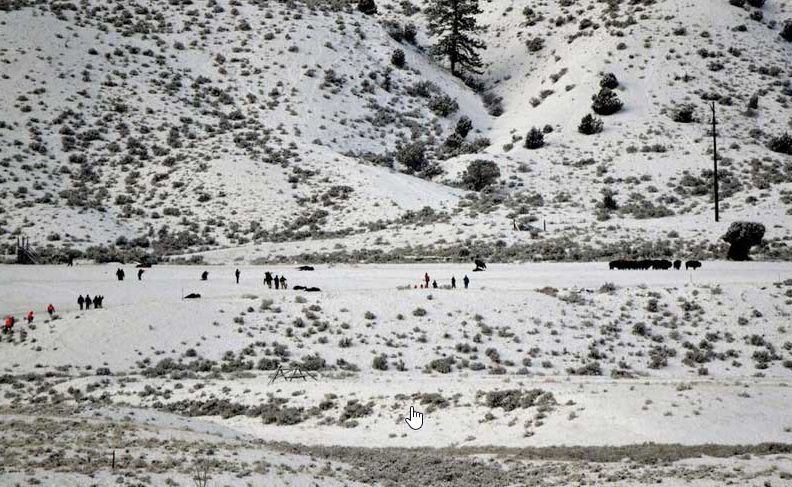
Images from the slaughter at Beattie Gulch, described above. Photos by Deleana Baker, Buffalo Field Campaign.
Make no mistake: BFC fully supports treaty rights and tribal sovereignty, yet our first priority is to the buffalo. What is taking place here is an extermination plan, and hunters are being used. We have to work in solidarity to demonstrate this, to end livestock control, and to get the buffalo — through migration — back on the landscape, in great numbers so that the proper, respectful relationships can be restored. Buffalo will take care of the people, but the people need to take care of them first. They need our help.
This whole Plan — which treaty hunting is certainly a part of from the government’s viewpoint, and all the discussions and decisions that happen within the IBMP — is in place to harm the buffalo and to keep them from restoring themselves across the landscape. We need to put our collective energy into fighting the IBMP and the law that places the Montana Department of Livestock in charge of buffalo in Montana. We must acknowledge that wild buffalo are ecologically extinct, and the IBMP is using hunting as well as slaughter and hazing to facilitate their destruction, to prevent their restoration.
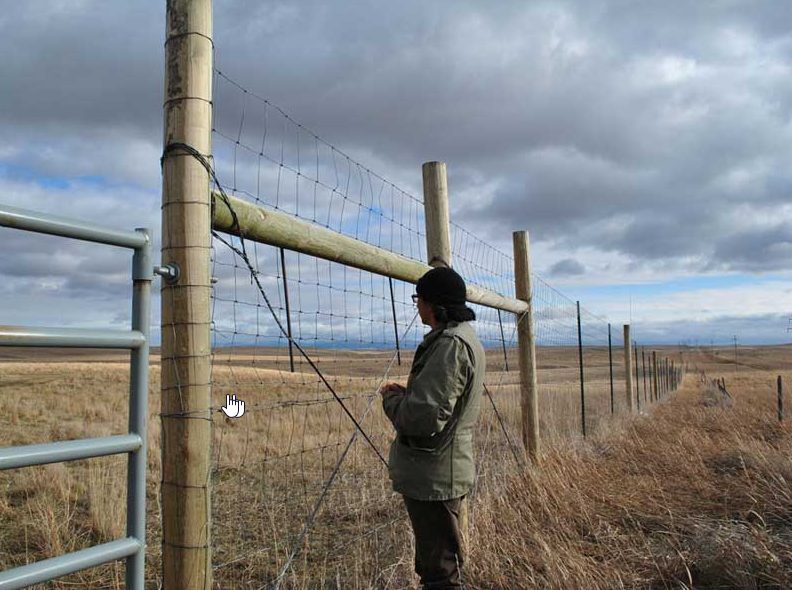
Catcher Cuts the Rope, Gros Ventre (A’aninin), looks into the formidable enclosure where quarantined Yellowstone buffalo now reside on the Ft. Belknap Indian Reservation. Photo by Stephany Seay, Buffalo Field Campaign.
The same can be said of quarantine, which is a management tool for livestock, not wildlife. Again, livestock interests present “choices”: dead buffalo or buffalo behind fences. Yellowstone National Park is aiming to develop a fifty-year plan for operational quarantine, making the process of domesticating wild, migratory buffalo an entrenched aspect of bison management. To be free or caged in is not an option in the wild world, it is a human option. Quarantine is something to satisfy the human; an easy way out, a toxic mimic of true wildlife restoration. It is a means to control what should be free. Quarantine is also part of the brucellosis lie, the premise being that bison pose a brucellosis threat, which we know to be untrue. Should elk be quarantined also? Elk have brucellosis but roam free.
The quarantine process begins with buffalo families being torn apart, adults shipped to slaughter, calves orphaned and raised in domestication. Then, those who survive the human-handling and testing of the quarantine process will live behind fences for the rest of their lives. We have seen the buffalo who suffered “living” in quarantine; they were not happy, they looked to get out of those pens. They were humiliated and afraid. Many of them have died horrible deaths because they could not escape their enclosures. Quarantine is part of the culture of death, this “civilized” system that systematically destroys life on the planet. Quarantine asks us to accept an “easy fix” that will give the human ego gratification.
Migration is free and alive; it is having the ability to make choices, being self-willed. Buffalo behind fences to be food for humans is a view that reduces them to meat. They have strong relationships with more than humans. The compromise should be in standing aside and respecting how a creature places one foot in front of the other — and we fight those things that get in the way of that. Quarantine removes the buffalo from their natural community, from life and their gift to life. Who is asking the buffalo’s perspective, asking them what they want? The buffalo will tell you that migration is they key to restoration. They know the way.
So many feel stuck in the “choices” that the government and industry have put before us. People believe that they are doing the buffalo a “favor” by hunting them, or by supporting quarantine, because otherwise they would be captured and shipped to slaughter. They are shipped to slaughter anyway. Having to pick hunt, quarantine, or slaughter is being forced to make artificial and unnecessary choices. So long as this Plan is in place, so long as Montana is in control, so long as wild buffalo numbers are driven down to serve livestock industry politics, and so long as wild buffalo are prevented from restoring themselves on the landscape, the problems will persist. We must fight this Plan and livestock control in all it’s guises. We must demand an end to livestock control, demand that wild buffalo walk the earth, demand an end to this management scheme.
One industry’s intolerance is driving a national treasure towards the brink of extinction. We must put an end to livestock industry control over wild buffalo, and to do so we must repeal the law — MCA 81-2-120 — that places them in charge. As evidenced by his decision to grant year-round habitat on Horse Butte, Montana Governor Steve Bullock is listening, but the livestock industry is trying to undermine his citizen-supported decision. He must hear from us all, frequently. Please contact Governor Bullock today, even if you have already, thank him for granting year-round habitat on Horse Butte and urge him to help repeal MCA 81-2-120. With endless pressure, endlessly applied, we can end livestock industry control and gain more of the buffalo’s Montana home for them to roam.
Thank you so very much for being with us for wild buffalo!

by Deep Green Resistance News Service | Jan 15, 2016 | Biodiversity & Habitat Destruction, Lobbying
Featured image: A bull buffalo lies dead, just outside Yellowstone’s north boundary. Photo by Stephany Seay, Buffalo Field Campaign
On January 12, the U.S. Fish and Wildlife Service (USFWS) denied Endangered Species Act protection for the iconic Yellowstone Bison. The agency’s decision comes 14 months after Western Watersheds Project and Buffalo Field Campaign petitioned to list these bison as an endangered or threatened species. The groups sought federal protection for the Yellowstone bison because these unique bison herds are harmed by inadequate federal and state management and other threats. In the finding, the USFWS now agrees that the Yellowstone bison are a distinct population of bison, reversing its 2011 position.
“If buffalo are to recover as a wild species in their native ecosystem, science must prevail over politics,” said BFC Executive Director Dan Brister. “The best available science indicates a listing under the Endangered Species Act is necessary to ensure the survival of this iconic species.”
“Friends of Animals is committed to protecting the last wild bison in America. We are disappointed in USFWS’s finding and suspect that the decision was improperly influenced by the interests of private ranchers in the area. We are reviewing the agency’s decision and plan to take further legal action if necessary,” stated attorney Michael Harris of Friends of Animals Wildlife Law Program.
“We petitioned the USFWS to list the Yellowstone bison because of clear management inadequacies and growing threats to this key population of wild bison. The USFWS decision is disappointing because protection under the Endangered Species Act is the only way to counter the management inadequacies and growing threats,” stated Michael Connor of Western Watersheds Project.
The groups’ petition catalogues the many threats that Yellowstone bison face. Specific threats include: extirpation from their range to facilitate livestock grazing, livestock diseases and disease management practices by the government, overutilization, trapping for slaughter, hunting, ecological and genomic extinction due to inadequate management, and climate change.
Federal and state policies and management practices threaten rather than protect the Yellowstone bison and their habitat. Since 2000, more than 4,000 bison have been captured from their native habitat in Yellowstone National Park and slaughtered. The Forest Service issues livestock grazing permits in bison habitat. The states of Montana, Idaho, and Wyoming forcefully remove or kill bison migrating beyond the National Park borders.
Once numbering tens of millions, there were fewer than 25 wild bison remaining in the remote interior of Pelican Valley in Yellowstone National Park at the turn of the 20th Century. The 1894 Lacey Act, the first federal law specifically safeguarding bison, prevented the extinction of these few survivors.
The agency’s justification can be found online at:
http://buffalofieldcampaign.org/ESA_90_Day_Finding.pdf
The petition to list Yellowstone bison is available online at http://www.buffalofieldcampaign.org/ESAPetition20141113.pdf
Visit Buffalo Field Campaign for field updates
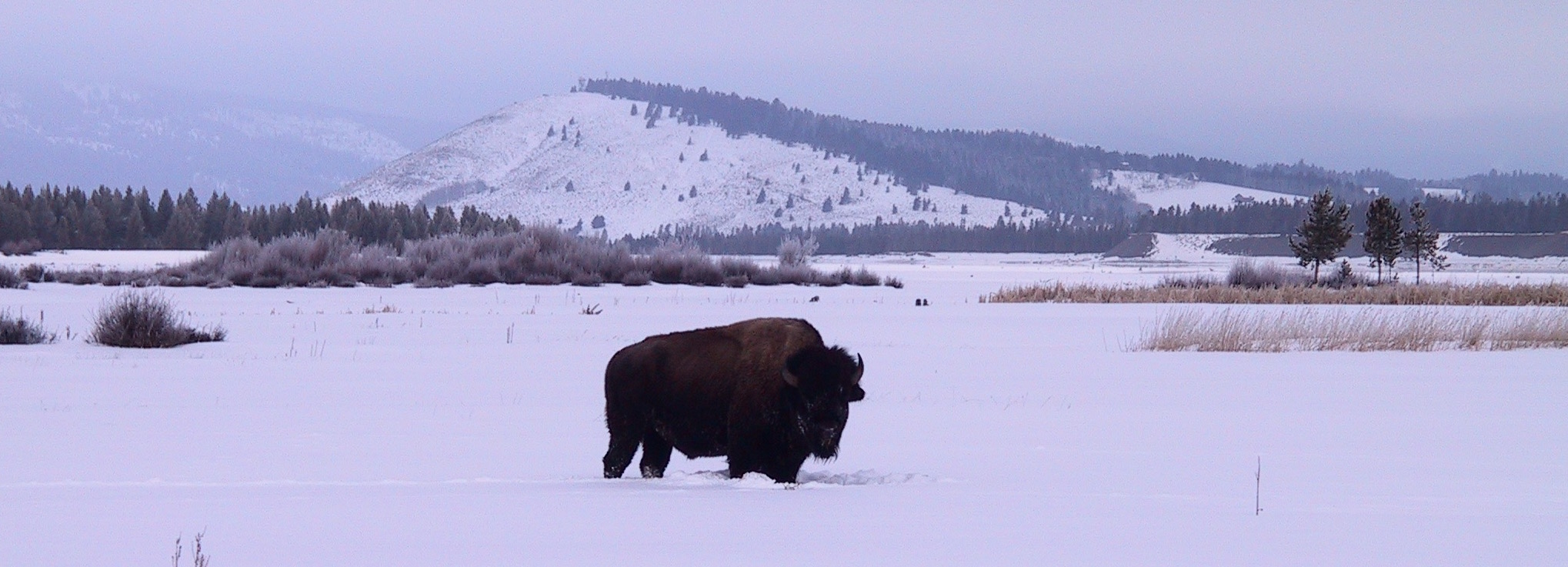
by DGR Colorado Plateau | Dec 24, 2015 | Listening to the Land, Lobbying
By Stephany Seay / Buffalo Field Campaign
Featured image: Hundreds of wild buffalo will no longer be harassed or otherwise harmed on the Horse Butte peninsula, seen in the distance here. Photo by Buffalo Field Campaign.
Yesterday, Montana Governor Steve Bullock issued his final decision on year-round habitat for wild bison in Montana, and Buffalo Field Campaign is very pleased to announce that after more than eighteen years of fighting for wild buffalo to freely roam Horse Butte, we have finally achieved this significant victory! As many of you know, Horse Butte is part of what we have been pressing for since the beginning of our campaign, and we are inclined to celebrate this achievement as the victory that it is; indeed, it may be the biggest victory we have had! It took nearly two decades of hard work in the field, in the courts, and in the policy arena to accomplish this, and it demonstrates how perseverance pays off, and how we must never give up.
This victory is a result of endless pressure, being endlessly applied by BFC, by you our dedicated supporters, by the incredible and active residents of Horse Butte, and by the buffalo themselves who consistently demonstrate resistance, persistence, and endurance. Another boon granted the buffalo is that bull bison — but only bulls — will be given year-round habitat in the Gardiner Basin. Please take a little time to celebrate this victory, as it has been hard-earned by each of you. Thank you to everyone who has been with us for the buffalo, making our work possible.
As we bask in this triumph, we cannot let down our guard. We must strengthen our resolve to continue fighting for wild buffalo and their right to roam the lands that are their birthright. We have many difficult battles yet to win. A closer look at Governor Bullock’s decision shows us that the buffalo are still in grave danger from livestock industry interests and the government agencies that serve them.
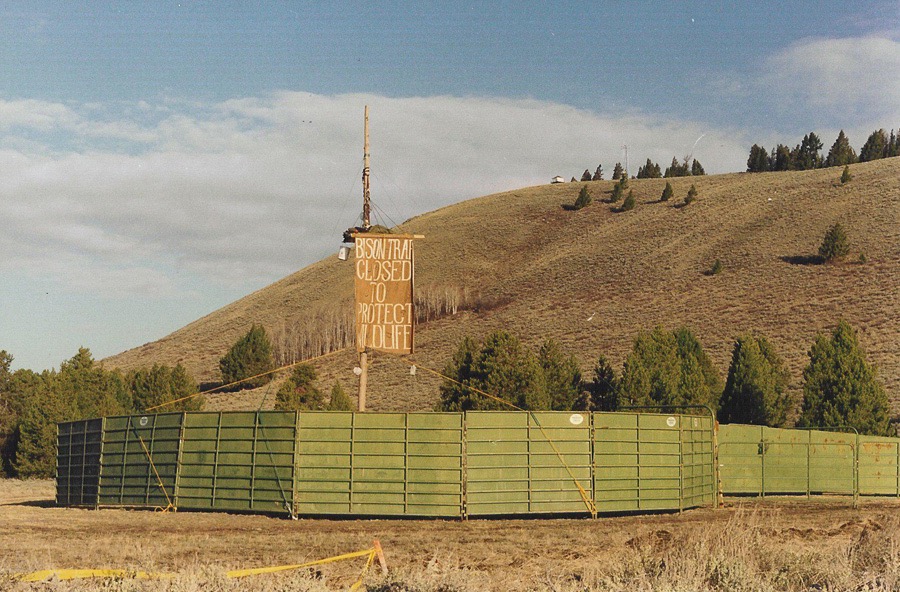
In 2004, the courageous and passionate Akiva Silver occupied the Horse Butte bison trap, saving many buffalo from being captured and shipped to slaughter. In 2008, the trap was again occupied by another brave individual, and the Montana Department of Livestock have not set it up since, nor will they ever again. Buffalo Field Campaign photo by Chris Rota.
Even the decision to grant buffalo year-round habitat on Horse Butte has its devilish details, mainly in the form of a population cap: during fall and winter approximately 450 buffalo will be allowed to live there; during the spring that number rises to 600, which is terrific timing since that’s when the large herds come to Horse Butte for calving season; but by July the government will allow only 250 buffalo to remain. From reviewing the Governor’s decision, it appears that, should there be more than 250 buffalo on Horse Butte by summer, hazing would not begin until then, which is about six weeks later than hazing has been taking place in recent years. While our ultimate goal is to put an end to all hazing, this means that wild buffalo will finally have the opportunity to make their own choices about when or whether to migrate into Yellowstone for the summer months. It will be an awesome gift to learn what they will do directly from the buffalo.
The deeper you look into the Governor’s decision, the more questions it raises. Hazing, hunting, and capture-for-slaughter remain tools that the livestock-backed government agencies will employ, with goals of keeping this highly vulnerable — and indeed, endangered — population at artifically low numbers. Additionally, wild buffalo will not be granted any “tolerance” along the south side of the Madison River, which is favored habitat, mostly public lands, that the matriarch-led family groups very much enjoy and require during the months surrounding calving season. Also, in the Gardiner Basin, matriarch-led family groups will not have full access like their adult male counterparts, but will be given tolerance only during “hunting” season, and will be hazed into Yellowstone by mid-spring.
Again, we have a long way to go for the buffalo. We need you to join with us in strengthening your resolve and renewing your commitment to do whatever it takes to defend our beloved wild buffalo until they roam free all across the lands that have been their home since buffalo time began.
Support Buffalo Field Campaign here.

by DGR Colorado Plateau | Dec 4, 2015 | Biodiversity & Habitat Destruction
By Stephany Seay / Buffalo Field Campaign
Buffalo are still absent here in the Hebgen Basin. Patrols are conducting daily recons, searching through the buffalo’s migration corridors, but the gentle giants are keeping themselves out of Montana and, consequently, safe from the killers.
Along Yellowstone’s north boundary, in the Gardiner Basin, buffalo haven’t been so lucky. Another eight buffalo have been killed by Confederated Salish & Kootenai (CSKT) hunters who are “harvesting” ecologically extinct wild bison because they have a treaty right to do so. We would suggest that the CSKT and other tribes who hold treaty rights to the Yellowstone region also have a right to healthy, viable populations of wild bison on all federally unoccupied, unclaimed lands. And we would further suggest that the Interagency Bison Management Plan, which is driving the destruction of America’s last continuously wild buffalo herds, is not only violating the lives of wild buffalo, but violating treaty rights as well.
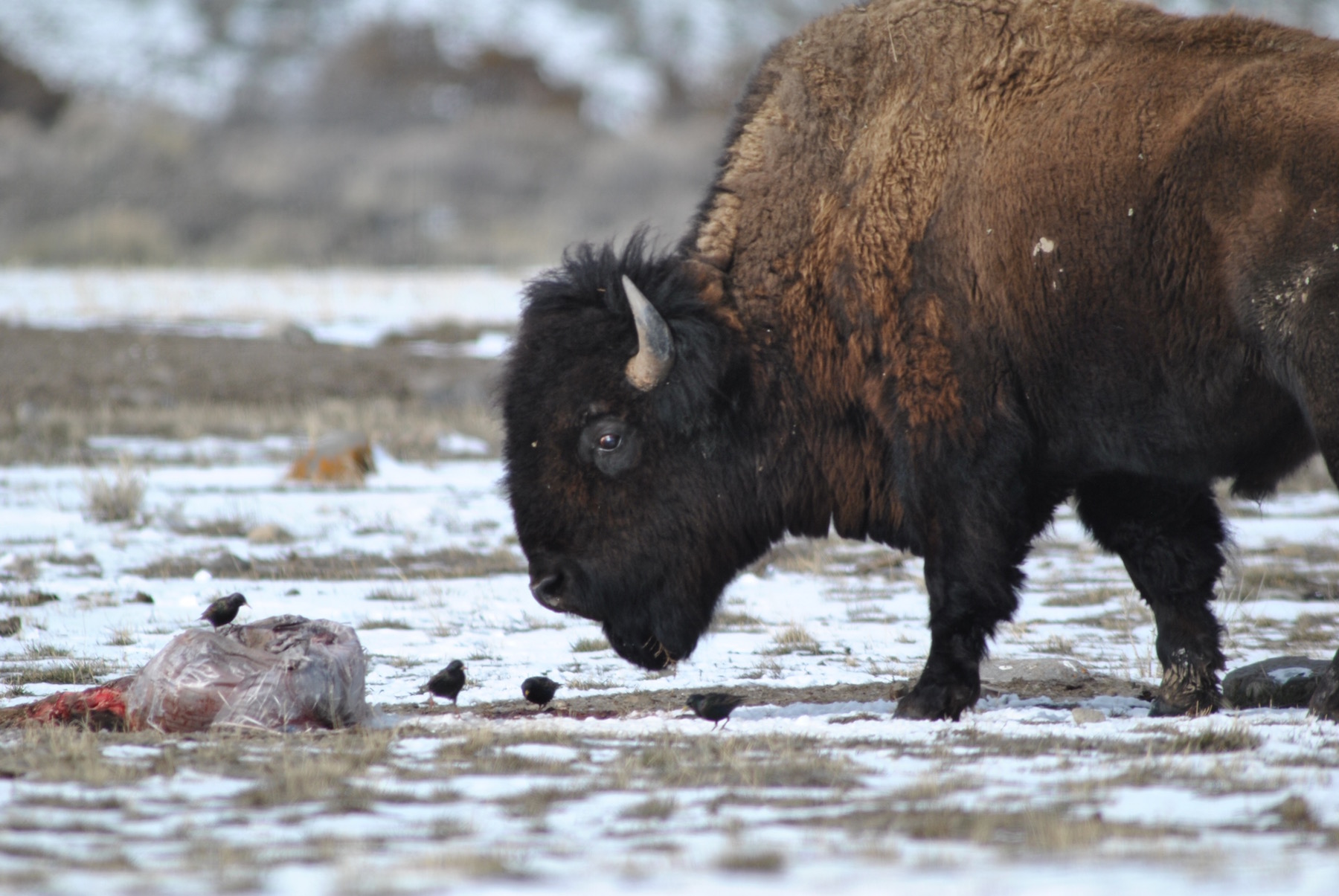
A bull bison approaches a relative’s remains, near Beattie Gulch, in the Gardiner Basin. Buffalo have intense family ties and deeply mourn the loss of those whom they love. Photo by Stephany Seay, Buffalo Field Campaign.
Most of the recent killings in Gardiner took place right outside Yellowstone’s boundary at Beattie Gulch, which is a tight bottle-neck corridor that the buffalo attempt to use to make it to other lower-elevation habitat in the Gardiner Basin. Hunters literally line up and wait for buffalo to cross the line from Yellowstone, where they can then be shot. Hunters and bison “managers” are aware that bison will seek the assumed safety of the Park when groups are shot at in this area. We have frequently seen hunters shoot into large and small groups of buffalo here, and the buffalo’s response has been to turn around and flee into the Park. This, according to Yellowstone, causes hunting to not be “effective” at killing enough, which, in turn, triggers Yellowstone’s response to initiate capture-for-slaughter operations. At the last Interagency Bison Management Plan meeting, some tribes had agreed to occasionally withhold from hunting right at the Park boundary to enable at least some buffalo to migrate to other expanses of habitat. Of course, these buffalo would still be pursued and eventually killed by hunters. The CSKT, who have killed the most through hunting this year and in years past, also hold an agreement with Yellowstone National Park to ship buffalo to slaughter. Since the CSKT also ship buffalo to slaughter, it’s not really in their interest to allow the buffalo to move further into the Gardiner Basin.
BFC’s Gardiner patrols have also reported that hunters from other tribes hunting under treaty, who normally start their seasons later in the winter going into early spring, have been arriving to Gardiner. With Yellowstone threatening slaughter, hunters are anxious to kill as many buffalo as possible before capture for slaughter begins. For the buffalo, it doesn’t matter if they cross the Park boundary or not, as they’ll likely be killed either way.

Many thanks to our friend and Gardiner resident, Fred Baker, for sharing this image with us.
The killing of the buffalo, whether it’s through “hunting” or slaughter, is all part of the Interagency Bison Management Plan (IBMP), which was crafted for the benefit of livestock interests, not buffalo. Even those hunting under treaty rights are being used by Montana’s livestock interests, and consequently, the IBMP, to facilitate the destruction of the buffalo and to prevent them from restoring themselves in Montana and elsewhere. Whether the excuse for these fatal tactics is brucellosis or population control, neither are based on reality, they only serve a political agenda. The IBMP exists because Montana livestock interests sued Yellowstone for “allowing” wild bison to migrate into Montana, and because of a law crafted by the livestock industry — MCA 81-2-120 — which places the Montana Department of Livestock in charge of managing wild bison. One industry’s intolerance is driving a national treasure towards the brink of extinction. We know you care deeply about wild bison, and one of the single most important things you can do is to help repeal this law. Contact Governor Steve Bullock today.
Wild is the Way–Roam Free!
–Stephany
Buffalo Field Campaign’s Mission: To protect the natural habitat of wild migratory buffalo and native wildlife, to stop the slaughter and harassment of America’s last wild buffalo as well as to advocate for their lasting protection, and to work with people of all Nations to honor the sacredness of wild buffalo.













